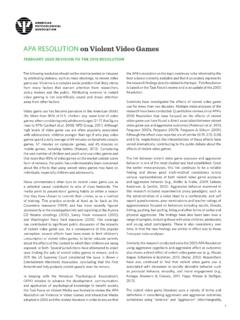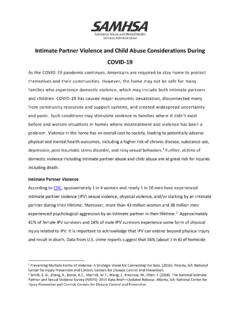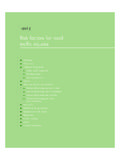Transcription of Latinos and Domestic Violence Fact Sheet
1 THE FACTS ON Latinos AND Domestic Violence . Hispanics and Latinos face many barriers when trying to get free from Domestic Violence . It is important to remember, however, that there is great diversity among Latinos . This diversity may account for some of the contradictory research results regarding the prevalence and incidence of Domestic Violence among Latinos . In fact, some of the research summarized below shows that factors such as acculturation and where a person is born affect their risk of Domestic Violence . However, more often Latinos are treated as a homogenous group, which complicates the interpretation of the results. The terms Hispanic and Latino are often used interchangeably. When reporting the results of a particular study, we use the same term as the researcher. Incidence and Prevalence of Domestic Violence : According to the 2010 Census, the Hispanic population grew by 43% and now accounts for 16% of the total population, whereas in 2000 Hispanics accounted for 13%.
2 Hispanics are the largest minority group in the United The number of Hispanics is projected to grow to by The National Violence Against Women Survey found that 21% of Latinas report experiencing physical assault at some point during their lives, and reported having experienced an intimate partner Also according to the National Violence Against Women Survey, Hispanic and non-Hispanic women report similar rates of physical assault and Between and 20% of Latinas report having been abused during the previous year4, with reporting experiencing some form of intimate partner Violence at some point in their Acculturation and Domestic Violence : Higher acculturation is associated with increased incidents of intimate partner US-born Mexican-Americans and Puerto Ricans have been found to have higher rates of intimate partner Violence than those that are born outside the United Evidence supporting a link between certain cultural beliefs associated with some Hispanic cultures and increased rates of Domestic Violence is mixed.
3 Also, although there is some evidence for protective factors in religiosity and social support, there is also evidence that these variables can be associated with increased Help-Seeking Behaviors: Ethnic minority women engage in less help-seeking behavior , other than police contact, than White Latina women underutilize formal helping resources because of language barriers, cultural barriers and differences, and fear and Latina women face obstacles to receiving help such as fear of deportation, social isolation, misinformation and lack of knowledge about legal rights, lack of knowledge about law enforcement capabilities and structure, language differences, and limited knowledge of the availability of social services to June 2010 (updated May 2015) THE FACTS ON Latinos AND Domestic Violence . Hispanic/Latino Sub-Groups: Associations between ethnic and cultural variables and the risk of Domestic Violence among Hispanic subgroups are difficult to determine as Hispanics are frequently treated as a homogeneous Depression and psychological distress are strongly associated with intimate partner Violence .
4 Ethnic minority individuals who live in poor neighborhoods may experience multiple risk factors for depression, including unemployment, poverty, frequent changes of residence, and multiple stressful life Differences in rates of intimate partner Violence between Latinos and non- Latinos have a tendency to disappear when factors such as age, urbanicity, alcohol consumption, proclivity to be impulsive, and family history of Violence are controlled for in the research About 6% of Latina women are abused during Abused Mexican-American women who report higher levels of spirituality also report higher levels of resilience in coping with intimate partner REFERENCES. 1. Humes, K. R., Jones, N. A., & Ramirez, R. R. (2011). Overview of race and Hispanic origin: 2010. Census briefs. Census Bureau. 2. Colby, S. L. & Ortman, J. M. (2015). Projections of the size and composition of the population: 2014 to 2060. Census Bureau. 3. Tjaden, P., & Thoennes, N. (2000). Full report of the prevalence, incidence, and consequences of Violence against women.
5 Department of Justice. 4. Klevens, J. (2007). An overview of intimate partner Violence among Latinos . Violence Against Women, 13(2), 111-122. 5. Lipsky, S., Caetano, R., Field, C. A., & Larkin, G. L. (2006). The role of intimate partner Violence , race, and ethnicity in help-seeking behaviors. Ethnicity & Health, 11(1), 81-100. 6. Coker, A. L., Sanderson, M., Cantu, E., Huerta, D., & Fadden, M. (2008). Frequency and types of partner Violence among Mexican American college women. Journal of American College Health, 56(6), 665-674. 7. Basuk, E., Dawson, R., & Huntington, N. (2006). Intimate partner Violence in extremely poor women: Longitudinal patterns and risk markers. Journal of Family Violence , 21(6), 387-399. 8. Bloom, T., Wagman, J., Hernandez, R., Yragui, N., Hernandez-Valdovinos, N., Dahlstrom, M., &. Glass, N. (2009). Partnering with community-based organizations to reduce intimate partner Violence . Hispanic Journal of Behavioral Sciences, 31(2), 244-257. 9. Denham, A.
6 C., Frasier, P. Y., Gerken Hooten, E., Belton, L., Newton, W., Gonzalez, P., Begum, M., & Campbell, M. K. (2010). Intimate partner Violence among Latinas in Eastern North Carolina. Violence Against Women, 13(2), 123 140. 10. Caetano, R., & Cunradi, C. (2003). Intimate partner Violence and depression among Whites, Blacks, and Hispanics. Annals of Epidemiology, 13(10), 661-665. 11. Rodriguez, M. A., Heilemann, M. V., Fielder, E., Ang, A., Nevarez, F., & Mangione, C. M. (2008). Intimate partner Violence , depression, and PTSD among pregnant Latina women. Annals of Family Medicine, 6(1), 44-52. 12. de la Rosa, I. A., Barnett-Queen, T., Messick, M., & Gurrola, M. (2015, May 6). Spirituality and resilience among Mexican American IPV survivors. Journal of Interpersonal Violence , published online pending print publication, 1-20. June 2010 (updated May 2015)






